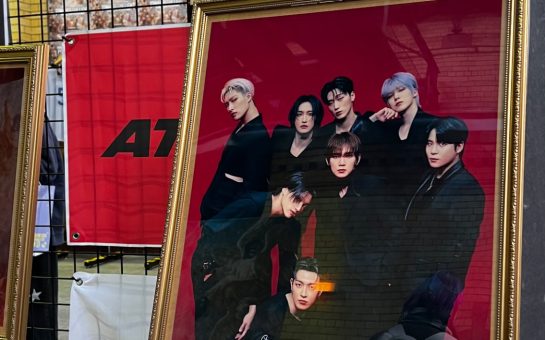The man who presented a dissected cow as a work of art is getting a taste of his own medicine as a Manchester-based artist takes Damien Hirst’s head for his latest work.
In his latest exhibition, Bring Me the Head of Damien Hirst, Manchester-based artist Richard Shields utilises the image of iconic British artist Damien Hirst as a starting point to explore his own ideas on religion, banking, consumerism and patronage in the art world.
For the exhibition, a large number of miniature Damien Hirst head sculptures were created, ten of which are due to be given to a selection of artists, galleries and collectors with the instruction to re-imagine the head in any way they see fit.
The use of assistants to create work under an artist’s instruction is a process that has been common in the production of artworks since the Renaissance, as Shields explained when discussing the ideas behind his latest project.
He said: “I’m looking at the idea of the hierarchy that was designed in the Renaissance.
“So you would have Medici bankers or Borgias Popes and they would be patrons of the arts. So they would employ people like Michael Angelo or De Vinci and then Michael Angelo and De Vinci would employ assistants beneath them…so that hierarchy’s been achieved.”
The exhibition looks at the idea of modern patronage in art and how the hierarchy described is still in place today.
Hirst provides a perfect example of the system at work having started as an artist in Leeds, rising up to become one of Britain’s largest collectors and assuming the role of patron.
In the words of Shields, Hirst became the Artist Pope.
Part one of the exhibition, currently on display at Barclay House, shows Shields’ own ideas and interpretations using the Hirst heads.
Part two will feature his selected assistants completed and returned, re-imagined heads. In contrast to artists such as Damien Hirst, his assistants have free-range to modify the head in any way they choose.
While referring to Hirst’s work and his use of unnamed assistants to produce much of his iconic work, Shields doesn’t believe the process in any way diminishes the work or the credit the artist has received.
He said: “Well, with Hirst It’s about the brand, Hirst is almost like a fashion house. It’s like the Hirst jeans you can get or t-shirts.
“He doesn’t weave the jeans himself; you don’t buy his t-shirt made by him.
“It’s the same with Ralph Lauren or any other big fashion house. They don’t make the individual clothes themselves – they design them.
“Art doesn’t necessarily have to be a painting anymore or a sculpture that’s made by the artist because Rembrandt didn’t necessarily finish all the paintings and it’s the same with Michael Angelo and the Sistine Chapel ceiling.
“So essentially the idea and the source are passed on through time. The assistants are executing his ideas – they’re taking it from a cerebral space and converting it into a physical body.”
Shields’ own work on display is intelligent and full of humour. The artist’s first piece, entitled Glossary Ossuary, is a direct tribute to Hirst’s own work, encapsulating the iconic diamond encrusted skull, the Spin Paintings and Hirst’s dissection series in one head.
In his other works the artist has used the Hirst heads to comment on a number of themes and ideas, such as patronage in the arts (Patron Hirst), retirement (Retirement Hirst) and religion’s influence on art (Demon Hirst).
Shields explained the ideas behind Demon Hirst: “So I get the idea that early religious work, in the Renaissance, is why we have this reverence and this preciousness about art today.
“If you think about the preciousness around the Turin Shroud or Spears of Destiny or things like that and then we start making paintings and the paintings become as holy as the original objects so there’s sanctity around them.”
In the iHirst room the artist explores Hirst as a brand, while poking fun at modern consumerism along the way, exploring the similarities between Hirst and the conglomerate.
Discussing iHirst, Shields said: “People will queue for hours outside an apple store to get their new iPad and apple products because it’s a thing to have – it’s bling. It’s basically an object of desire.
“So Hirst, in a way has created that same thing for himself. When a new series of paintings come out there’ll be online buyers, there’ll be telephone buyers waiting and he’ll sell out.
“So what I’ve tried to do here is try and combine those two megaliths – so you’ve got Apple and Hirst together in iHirst Pro and iHirst Pro-S.”
The iHirst room also features a pre-owned version of the iHirst, based on an older Apple product, such as the iPod classic and set in one of the mass-produced, plastic packaging, reconditioned and returned Apple products are shipped in.
An aging version and broken example complete the display.
Grandmother’s Pearl Hirst, draws comparison with Hirst’s diamond-encrusted skull, commenting on how the value of an object is defined by more than just the monetary value of the object.
As the artist explains: “Damien Hirst’s Diamond skull is worth £34million more than the actual carat diamonds inside it, so because it’s art, because it’s Hirst, its got this extra value.
“That’s the same thing that happens with family heirlooms. When someone dies and passes something down it’s been given this extra value that’s only really in the eye of the beholder.”
Shields’ versions of the heads will be on display at Barclay House, Whitworth Street until Sunday.
Part two, featuring heads produced by Shields’ selected Patrons, including Islington Mill Studios, Cornerhouse Cinema, Own Art and Axisweb, will be on display from July 18 at Piccadilly Place.
More of the artist’s work and information about Bring Me the Head of Damien Hirst is available at http://richardshields.blogspot.co.uk/
Picture courtesy of Bring Me The Head of Damien Hirst Part one via Facebook, with thanks
For more on this story and many others, follow Mancunian Matters on Twitter and Facebook.



